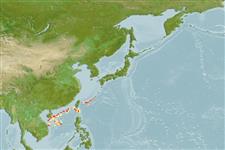Environment: milieu / climate zone / depth range / distribution range
Ecology
Marine; bathydemersal; depth range 500 - 1100 m (Ref. 9905). Deep-water; 31°N - 4°N, 109°E - 130°E (Ref. 114953)
Northwest Pacific: Vietnam to southern Japan, including Taiwan, Hongkong and Philippines (Ref. 114953).
Size / Weight / Age
Maturity: Lm ? range ? - ? cm
Max length : 59.0 cm TL male/unsexed; (Ref. 9905)
Maximum width at least 38 cm. Seldom caught. Utilization for human consumption limited (Ref. 9905). Found in soft, sandy bottoms; by-catch of trawls and usually discarded because of its small size (Ishihara, pers.comm. 07/07). Males reaches maturity at ca. 53 cm TL (Ref. 114953)
Life cycle and mating behavior
Maturity | Reproduction | Spawning | Eggs | Fecundity | Larvae
Distinct pairing with embrace (Ref. 205).
McEachran, J.D. and K.A. Dunn, 1998. Phylogenetic analysis of skates, a morphologically conservative clade of elasmobranchs (Chondrichthyes: Rajidae). Copeia 1998(2):271-290. (Ref. 27314)
IUCN Red List Status (Ref. 130435: Version 2024-2)
Threat to humans
Harmless
Human uses
Fisheries: bycatch
Tools
Special reports
Download XML
Internet sources
Estimates based on models
Preferred temperature (Ref.
123201): 6.3 - 8.2, mean 6.5 °C (based on 11 cells).
Phylogenetic diversity index (Ref.
82804): PD
50 = 0.5020 [Uniqueness, from 0.5 = low to 2.0 = high].
Bayesian length-weight: a=0.01000 (0.00244 - 0.04107), b=3.04 (2.81 - 3.27), in cm total length, based on all LWR estimates for this body shape (Ref.
93245).
Trophic level (Ref.
69278): 3.8 ±0.49 se; based on food items.
Resilience (Ref.
120179): Low, minimum population doubling time 4.5 - 14 years (Assuming fecundity<100).
Fishing Vulnerability (Ref.
59153): Moderate vulnerability (44 of 100).
